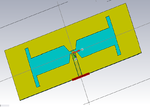Sherry1
Member level 3
- Joined
- Apr 4, 2013
- Messages
- 61
- Helped
- 0
- Reputation
- 0
- Reaction score
- 0
- Trophy points
- 1,286
- Location
- Manchester, UK
- Activity points
- 1,810
I came up with a preliminary antenna design which has a fair return loss, S11 = -14dB in simulation at 1.5GHz
However it has poor radiation efficiency as shown in figure

Radiation efficiency = -29.64dB
Total efficiency = -29.79dB
How can I improve it? What is the standard range of radiation efficiency for a good RX antenna?
Quick note:
1. This is intended to be used for receiver system.
2. Ground plane = 40x20mm.
3. Its a slot antenna.
However it has poor radiation efficiency as shown in figure

Radiation efficiency = -29.64dB
Total efficiency = -29.79dB
How can I improve it? What is the standard range of radiation efficiency for a good RX antenna?
Quick note:
1. This is intended to be used for receiver system.
2. Ground plane = 40x20mm.
3. Its a slot antenna.

